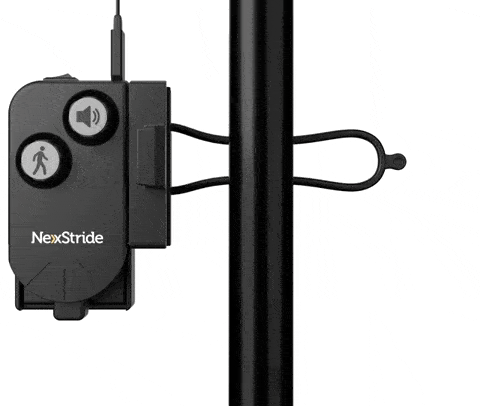Get Better Mobility Outcomes, Faster.
Introduce your clinic to the award-winning portable mobility device that enables your patients to overcome their gait deficits and regain functional independence.
⭐⭐⭐⭐⭐
“The NexStride cueing device has clear added benefit for patients with gait disorders diagnosed with Parkinson’s, as well as stroke, vestibular dysfunction, brain injury and a range of other conditions.”
 Maria Allen
Maria Allen
Physical Therapist, Central Coast Home Health &
Coordinator Parkinson’s Disease Wellness Program






NexStride is a gait training device that significantly benefits patients with abnormal gait and movement disorders resulting from a variety of neurodegenerative conditions1, as well as rehabilitation from sudden events such as stroke2.
NexStride uniquely combines proven effective audio and visual cues into one compact, portable device that easily attaches to walking frames, canes or walking poles and can be activated when required.
Used in physical therapy sessions, NexStride has been shown to be effective for:
NexStride has been shown to achieve:
Parkinson’s Disease
- 69% reduced duration of freezing episodes
- 43% reduced frequency of freezing episodes
- 40% reduced frequency of falls
Stroke
- Increase walking speed by .23m/s
- Increase stride length by .21m
- Improve mobility by 56% for visual cueing and 73% for auditory cueing
Movement Disorders
- Parkinson’s Disease
- Traumatic Brain Injury
- Stroke
- Cerebral Palsy
- Spinal Cord Injury
- Multiple Sclerosis
- Huntington’s Disease
- Muscular Atrophy
- 3PD
Gait Impairments
- Freezing of Gait
- Ataxic Gait
- Asymmetric Stepping
- Short Stepping
- Shuffling
- Scissoring
- Poor Balance
- Narrow Stance (BOS)
- Slow Gait Speed
Already used in well over 100 physical therapy practices across the continuum of care, NexStride is improving balance, stride length, step length and gait speed. All of these result in clinical improvements in fall-risk assessments such as Timed-Up-Go, Tinetti, and Berg Balance tests.
1 Donavan S, et al. Laserlight cues for gait freezing in Parkinson’s disease: An open-label study. Parkinsonism and Related Disorders 2011; 17:240-245.
Velik R, et al. The effect of visual cues on the number and duration of freezing episodes in Parkinson’s patients. 34th Annual Intl Conf of IEEE EMBS, San Diego, California 2012.
2 https://pubmed.ncbi.nlm.nih.gov/25529836/
https://www.ncbi.nlm.nih.gov/pmc/articles/PMC6004404/
Easy, Portable Sensory Cues
Six Critical Benefits for Physical Therapists and Movement Specialists
Evaluate gait in seconds
Use NexStride’s laser light to easily see exactly how long, and how even your patient’s strides are. Use the metronome to assess walking speed.
Optimize for effectiveness
Quickly identify and make gait corrections on the spot, adjusting NexStride’s laser light position or metronome speed for support.
Spend less time being the cue
Increase your productivity and effectiveness when you can observe and coach for improvement instead of cueing your patient.
Quickly adaptable to every patient
Forget laying out floor markers that can’t be adjusted to suit. Simply attach NexStride to a walking frame, cane or walking poles, and your patient is ready to go.
Enable access to proven cues
Use NexStride’s effectiveness to allow patients to build up strength and improve mobility faster, without fear of setbacks through falling.
Improve patient engagement
Let NexStride make it easier for patients to adopt the walking aid they need, by showing them how they can regain the power of movement.
Hear it from physical therapists using NexStride
⭐⭐⭐⭐⭐
“Both myself and my patients have found it of significant benefit regarding 1) improving stride length, 2) reducing frequency of shuffling, 3) improving toe clearance, and 4) providing both a visual and mental stimulus to restore a more normal gait pattern”
– Mark Medcalf
PT, Seven Oaks Physical Therapy, Westlake Village, California
⭐⭐⭐⭐⭐
“The rehab facility in which I work has been using NexStride with our stroke patients. We have seen significant improvements in their gait pattern…We also have seen improvements carried over when we don’t use NexStride in subsequent sessions”
– Marissa Cummo
DPT, PT, Bellevue Hospital Center, NYC Health + Hospitals
⭐⭐⭐⭐⭐
“With the use of the Nexstride I can focus on giving support to the patient.
The NexStride gives that visual and auditory cueing for step length and cadence that improves my ability to give the tactile cues and physical support for gait training. “
– Kelli Trent
DPT, Bassett Physical Therapy, Stanleytown, VA
⭐⭐⭐⭐⭐
“Other devices with similar visual cueing are not nearly as portable. A large majority of post-stroke patients depend on devices with unilateral upper extremity and cannot effectively use U-Step styled walkers. NexStride can be attached on a hemi-walker, quad cane or single point cane to cue.”
– Jesse Klimek
PT, DPT, NCS Stanford Outpatient Neurological Rehabilitation
Getting Started With NexStride

- Attach.
Fasten NexStride to your patient’s walking frame, walker, walking stick or walking poles as you begin their gait session, so the control buttons are at their fingertips. - Set.
Position the green laser so it’s ideal for your patient’s stride length, balance and posture. Adjust the metronome volume and tempo to achieve their ideal pace. - Go.
Have your patient press the buttons to activate either the visual or the auditory cue, or both, whenever needed to begin walking, or to maintain their stride.
Try it Free for 30 Days
Free shipping. One year warranty. Money back guarantee.
NexStride is available for immediate purchase, with a 30-day money back guarantee. Alternatively, you can apply for a trial unit to test its effectiveness with your specific clinic’s case load.
Get NexStride — risk free — today👇

